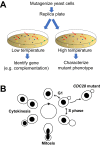Sophisticated lessons from simple organisms: appreciating the value of curiosity-driven research
- PMID: 29259023
- PMCID: PMC5769611
- DOI: 10.1242/dmm.031203
Sophisticated lessons from simple organisms: appreciating the value of curiosity-driven research
Abstract
For hundreds of years, biologists have studied accessible organisms such as garden peas, sea urchins collected at low tide, newt eggs, and flies circling rotten fruit. These organisms help us to understand the world around us, attracting and inspiring each new generation of biologists with the promise of mystery and discovery. Time and time again, what we learn from such simple organisms has emphasized our common biological origins by proving to be applicable to more complex organisms, including humans. Yet, biologists are increasingly being tasked with developing applications from the known, rather than being allowed to follow a path to discovery of the as yet unknown. Here, we provide examples of important lessons learned from research using selected non-vertebrate organisms. We argue that, for the purpose of understanding human disease, simple organisms cannot and should not be replaced solely by human cell-based culture systems. Rather, these organisms serve as powerful discovery tools for new knowledge that could subsequently be tested for conservation in human cell-based culture systems. In this way, curiosity-driven biological research in simple organisms has and will continue to pay huge dividends in both the short and long run for improving the human condition.
Keywords: C. elegans; Drosophila; Invertebrates; Sea urchin; Yeast.
© 2017. Published by The Company of Biologists Ltd.
Conflict of interest statement
Competing interestsThe authors declare no competing or financial interests.
Figures



References
-
- Aagaard L., Laible G., Selenko P., Schmid M., Dorn R., Schotta G., Kuhfittig S., Wolf A., Lebersorger A., Singh P. B. et al. (1999). Functional mammalian homologues of the Drosophila PEV-modifier Su(var)3-9 encode centromere-associated proteins which complex with the heterochromatin component M31. EMBO J. 18, 1923-1938. 10.1093/emboj/18.7.1923 - DOI - PMC - PubMed
Publication types
MeSH terms
Grants and funding
LinkOut - more resources
Full Text Sources
Other Literature Sources
Molecular Biology Databases
Miscellaneous

